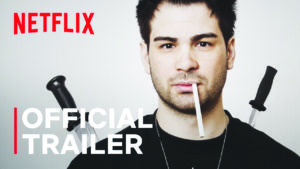The most hated man on the internet, according to a new Netflix docuseries, is Hunter Moore. The convicted criminal and self-described “professional life ruiner” Moore enabled the non-consensual distribution of thousands of private images by founding “revenge porn” website Is Anyone Up?.
 The documentary captures what revenge porn is, how it is carried out and how traumatic it can be for victims. The women in the series were not stereotyped as being naïve or at fault, as they often are in media coverage. The series showed how the thousands of people who share the image play a role in revenge porn, not just the first person to upload them.
The documentary captures what revenge porn is, how it is carried out and how traumatic it can be for victims. The women in the series were not stereotyped as being naïve or at fault, as they often are in media coverage. The series showed how the thousands of people who share the image play a role in revenge porn, not just the first person to upload them.
As a former probation officer, I’m interested in how society views sexual crime, and how we treat women who are victims. The docuseries could have gone further by talking about brave women as victims of gender-based violence, not just “revenge porn”.
This term overlooks that private images shared without consent are not always actually pornographic. It also blames the victim, because it suggests they did something to deserve revenge. While I’ve used it above as most readers will be familiar with the term, for the rest of the article I will talk instead about image-based sexual abuse.
The series doesn’t make especially clear that it is normal to take and send images of yourself as part of sexual self-expression, but when someone shares them without consent, it can be a form of domestic abuse. The internet is saturated with such images. There are now over 3,000 websites dedicated to image-based sexual abuse, and reports to the government’s revenge porn helpline are increasing year on year.
Victims of revenge porn become isolated and frightened of what others think of them. Because of this, many experience mental health issues including PTSD and depression.
As the docuseries showed, victims are usually female. Data from early 2022 shows that in the UK, 81% were. Their images are generally shared without their permission by men, though not usually those who hack into their accounts. Most image-based sexual abuse is perpetrated by ex-partners.
Many people imagine an angry ex-partner commits this crime for retaliation after an unwanted break-up. However, this is not always the case. A 2021 study of over 2,000 British people conducted by the law firm Slater & Gordon found some men wanted to scare their victim. Others thought it was “a laugh”, an attitude shared by the perpetrators in the Netflix documentary.
We live in a society where misogyny and male entitlement leads to violence against women and girls. “Upskirting” and images of breastfeeding taken without consent are also forms of sexual abuse, and evidence of the sexual harm caused to women in our society. A 2017 study found that the impact on victims of this kind of sexual abuse is similar to that of sexual assault. On this basis, many campaigners and researchers argue it should be a specific sexual crime.
What the series doesn’t cover
The Most Hated Man on the Internet series gave a sense of what was happening in the US, but not in the UK. To tackle this crime, the UK government is trying to regulate the internet. The online safety bill proposes forcing internet providers to be more proactive in removing image-based sexual abuse, rather than waiting for victims to report it.
In England and Wales, “revenge porn” became a specific offence in 2015, with a penalty of up to two years in prison. The threat of sharing non-consensual private images became illegal in 2021.
Even with these laws, victims are understandably reluctant to speak to police. This isn’t helped when police officers don’t have enough training or understanding about these experiences. Some officers have blamed women for being victims of image-based sexual abuse. Currently, only a fraction of police reports of image-based sexual abuse lead to a charge or summons to court.
When victims do report, one third of them don’t pursue a charge because they cannot be guaranteed anonymity in a “communications offence”. If image-based sexual abuse was a sexual offence, then victims would have to be kept anonymous.
Victim support
Another thing the docuseries showed was the importance of family support, both for the victim on an emotional level, and in seeking justice. The highlight of the series, for me, was Charlotte Laws, the mother of one of Moore’s victims. She campaigned against his website, and didn’t stop once her daughter’s image were taken down. She supported other victims and the FBI in a fight for justice against Hunter Moore.
Victims of image-based sexual abuse clearly need support, but not all have someone like Charlotte. Destiny Benedict, another of Moore’s victims, has since discussed how vulnerable and isolated she felt during her experience. The docuseries portrays Moore manipulating Benedict into sending him more content so he would remove photos of her children from his website.
The UK government has recently increased funding for the Revenge Porn Helpline. The helpline is a place for people to report being a victim, but also a source of support which helps take images down.
The Most Hated Man on the Internet has drawn important attention to this issue, but there is more we can all do to support victims of revenge porn, starting with recognising it for the abuse it is. (The Conversation)



